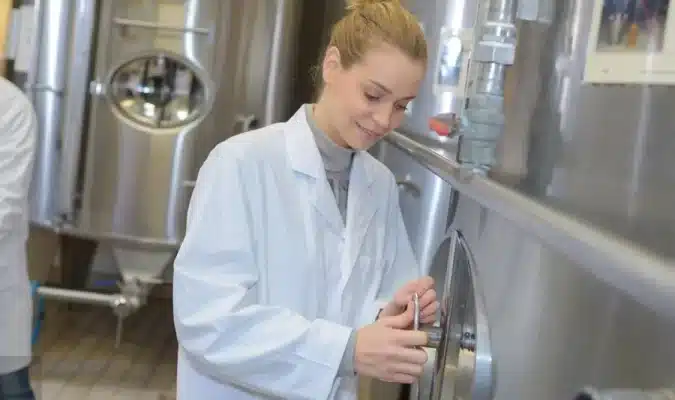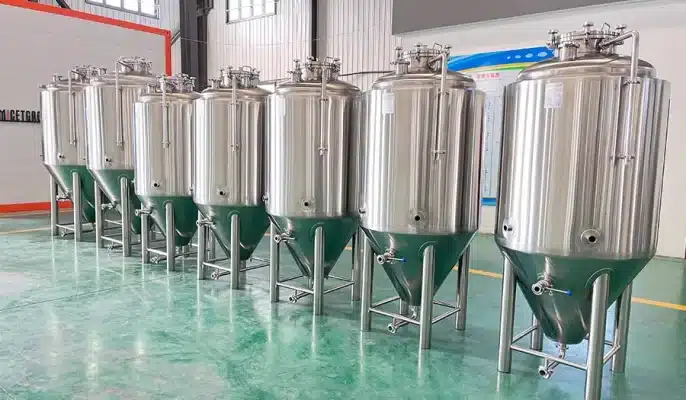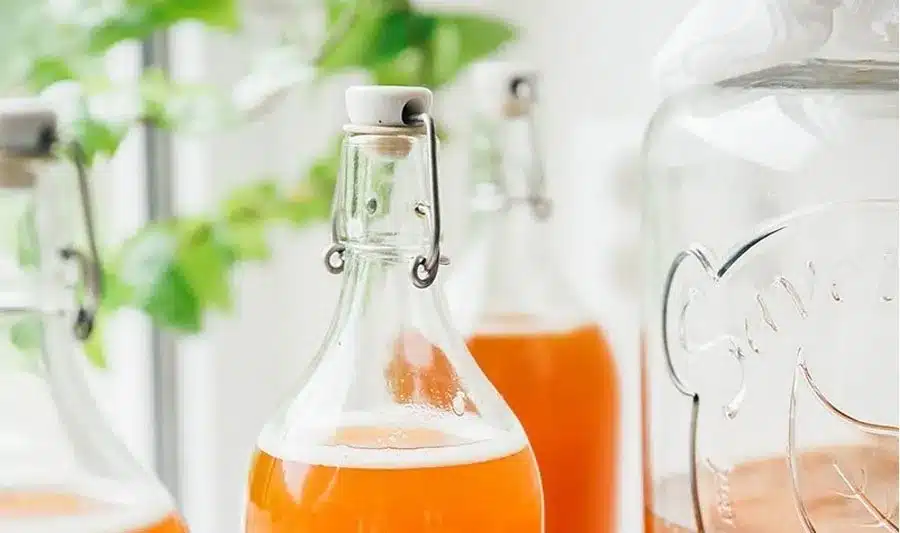In the wonderful journey of brewing kombucha, an often overlooked but crucial link is to choose the right brewing container. The kombucha equipment container not only affects the fermentation effect but also largely determines the quality and taste of the final product. Having the best container for brewing kombucha is the key first step to starting this delicious fermentation.
What is Kombucha?
Kombucha is a probiotic beverage made from fermented tea. It has become trendy in recent years due to its good taste and many health benefits such as improved digestion and intestinal health, detoxification, and immune system enhancement. The kombucha production process involves mixing tea with sugar and adding an active culture called SCOBY (symbiotic bacteria), which includes bacteria and yeast. Under the right environment, the fermentation process converts sugar into organic acids, bubbles, and various flavor components, resulting in kombucha’s unique sweet and sour taste and delicate bubbles.
Kombucha Brewing Equipment Materials
- Glass: Glass is easy to clean and won’t leach any chemicals during the fermentation process. You can choose from a variety of fun shapes and sizes of glass for brewing and even glass that comes with a continuous brewing feature if you choose to do it continuously. Plus, you can see all the fun things happening inside the tank during the fermentation process.
- Stainless Steel: This is our recommended choice. This material may be a little more expensive, but it is safe to use and easy to clean. If you want to brew more than 2-3 gallons of kombucha at a time, you’ll want to go with stainless steel because it’s much lighter than glass.
- Ceramic: Ceramic is a great choice if you decide to go with the continuous brewing method because it will usually sit on your counter. The SCOBY isn’t the best kitchen decor, so you can choose a nice ceramic home to house it. Be careful when choosing a ceramic container because some glazes contain lead, which can leach into your brew.
- Plastic: You can use plastic, but be sure to use high-density polyethylene (HDPE) because this plastic is safe for fermentation. HDPE is widely used to make fermentation tanks for beer brewing and winemaking.

Kombucha brewing process
Prepare raw materials
- Tea: You can choose green tea, black tea, oolong tea, and other teas. Generally, 5-10 grams of tea per liter of water is appropriate. Different teas will give kombucha different flavor characteristics. For example, green tea kombucha tastes relatively fresh, while black tea kombucha tastes more intense.
- Sugar: White sugar or rock sugar is commonly used, which provides energy sources for microorganisms. About 50-100 grams of sugar are added per liter of water. The specific amount can be fine-tuned according to personal preference. More sugar may ferment slightly faster, but the finished product may be sweeter.
- Water: Choose clean, chlorine-free drinking water, such as filtered water or bottled water. The water quality will affect the taste and quality of kombucha.
- Kombucha mother bacteria (SCOBY): This is the key to brewing kombucha. It is a symbiotic bacterial community formed by microorganisms such as yeast and acetic acid bacteria. It looks like a thick, translucent gelatinous substance. It can be obtained from existing kombucha brewers or purchased ready-made.
Equipment
- Stove or electric kettle: used to boil water.
- Tea filter or filter bag: used to filter tea leaves.
- Stirring tools: such as a clean long-handled wooden spoon or plastic spoon, which is convenient for stirring the raw materials evenly.
- Thermometer: monitor the fermentation temperature.
- Measuring cup and scale: accurately measure the amount of water, sugar, etc.
Make sugar tea liquid
- Boil water: Use a stove or electric kettle to boil an appropriate amount of water.
- Brew tea leaves: Put the selected tea leaves in a heat-resistant container, pour in boiling water, and soak for 5-10 minutes (the soaking time can be adjusted appropriately for different tea leaves) to allow the tea leaves to fully release the active ingredients.
- Add sugar: Add the pre-weighed sugar to the soaked tea water, and stir until completely dissolved to form a sugar water tea liquid.
- Filter tea leaves: Use a tea filter or filter bag to filter out the tea residue to obtain a clear sugar water tea liquid, and set it aside to cool to room temperature.
Add yeast to start fermentation
- Prepare containers: Place the selected clean glass container or stainless steel fermentation tank in a stable place.
- Put in yeast: Gently put the Kombucha yeast into the sugar water tea liquid-cooled to room temperature, making sure that the yeast is completely immersed in the liquid. The yeast will slowly sink to the bottom of the container.
- Stir evenly: Use a stirring tool to gently stir the liquid in the container to fully mix the yeast and sugar water tea liquid so that the microorganisms can be evenly distributed in the solution to start the fermentation process.
- Cover the container: You can gently cover the container mouth with a clean cloth or a special fermentation cover to prevent dust and other impurities from entering and keep the container breathable to a certain extent to meet the oxygen needs of microorganisms in the early stage of fermentation.
Harvest Kombucha
In addition to taste, you can also judge whether the fermentation is complete by appearance. When the rate of bubble generation in the container slows down significantly and the bacterial film becomes thicker and more stable, it usually means that the fermentation is close to completion. When you are sure that the fermentation is complete, you can harvest the kombucha. Use a clean filter or filter bag to filter the kombucha into a clean storage container, such as a glass bottle, and seal it. The kombucha obtained at this time can be drunk directly or further refrigerated to extend its shelf life.

Equipment Needed to Brew Kombucha
- Brewing Pot: The brewing pot is an essential piece of equipment for brewing sweet tea, the first ingredient of kombucha. It allows the brewer to control the temperature, time, and composition of the sweet tea to produce a consistent, high-quality kombucha.
- Fermentation Tank: A fermentation tank is a large container, usually made of stainless steel, used to ferment kombucha. The fermentation tank should be equipped with temperature control, agitation, and airflow systems to maintain optimal conditions for kombucha culture and prevent contamination.
- Filtration and Bottling Equipment: Filtration and Bottling Equipment is used to remove particles and sediment from kombucha and transfer it to bottles or other containers. Filtration and Bottling Equipment should be able to handle the flow and pressure of kombucha and prevent spills, leaks, and waste.
- Labeling and Packaging Equipment: Labeling and Packaging Equipment is used to apply labels and seals to bottles or other containers and package them in cartons or other materials. Labeling and Packaging Equipment should be able to apply labels and packages accurately and efficiently and ensure that they fit and seal properly.
- Refrigeration Equipment: Refrigeration equipment is used to cool and store kombucha before and after packaging. Refrigeration equipment should be able to maintain the required temperature and humidity to prevent the kombucha from spoiling.
- Cleaning and sterilizing equipment: Cleaning and sterilizing equipment is used to clean and sterilize fermentation tanks, filtration and bottling equipment, and other surfaces and utensils to prevent contamination and spoilage. Cleaning and sterilizing equipment should be able to remove dirt and debris and kill bacteria and other microorganisms without damaging the equipment or the kombucha.
How to choose the best kombucha brewing equipment?
- Brewing goals: Understand whether you are brewing for personal consumption, sharing with friends and family, or want to start a small business. This will help you choose the right size and type of equipment.
- Budget: Create a budget for your equipment. While the initial investment may be higher, quality equipment can save time and energy in the long run.
- Brewing method: Decide whether to use batch brewing or continuous brewing. Batch brewing makes a new batch of tea each time, while continuous brewing allows new tea and sugar to be added during the fermentation process. Continuous systems, while more expensive, provide a constant supply of kombucha and are quick and convenient.
- Fermentation container: Choose a fermentation container made of food-grade materials, such as glass, stainless steel, or ceramic. Avoid plastic or metal containers, as they may react with the acidity of kombucha or release chemicals. Make sure the container has a wide opening for easy cleaning and removal of the SCOBY and has a sealing lid to prevent contamination.
- Size: Choose the right container for the amount of kombucha you plan to brew. One-gallon (3.8-liter) jugs are a common starting choice for home brewing.
- Temperature Control: Kombucha fermentation requires a steady temperature (68-78°F, 20-26°C). In colder climates or when it’s difficult to maintain that temperature range, consider purchasing a heating pad or temperature control system.
- Accessories: Get essential brewing accessories, such as a cloth cover or airlock for your fermentation vessel, a food-grade thermometer, a pH meter or test strips, and a long-handled spoon for stirring.
- SCOBY and Fermentation Liquid: Make sure you have a healthy SCOBY (symbiotic culture of bacteria and yeast) and fermentation liquid. Buy from a reliable friend, online store, or local kombucha supplier.

FAQ
What materials can a kombucha fermentation container be made of?
It is best to use food-grade glass, stainless steel, or ceramic for the fermentation container. Avoid using plastic or metal containers, as these materials may react with the acidity of kombucha or release harmful substances.
How big does the fermentation container need to be?
Choose a fermentation container based on the amount you want to brew. A common starting container for home use is 1 gallon (3.8 liters). If you plan to brew a large amount of kombucha, you can choose a larger container.
What is the purpose of a tea strainer or filter bag?
When brewing kombucha, the purpose of a tea strainer or filter bag is to separate the tea leaves from the tea water after brewing.
What is the purpose of a stirring tool in brewing kombucha?
When mixing sugar water with tea water, you need to use a stirring tool to stir them thoroughly to ensure that the sugar is evenly distributed in the tea water. When adding starter ferments such as yeast liquid or biofilm, you also need to use a stirring tool to stir them thoroughly with the sugar water tea liquid.




